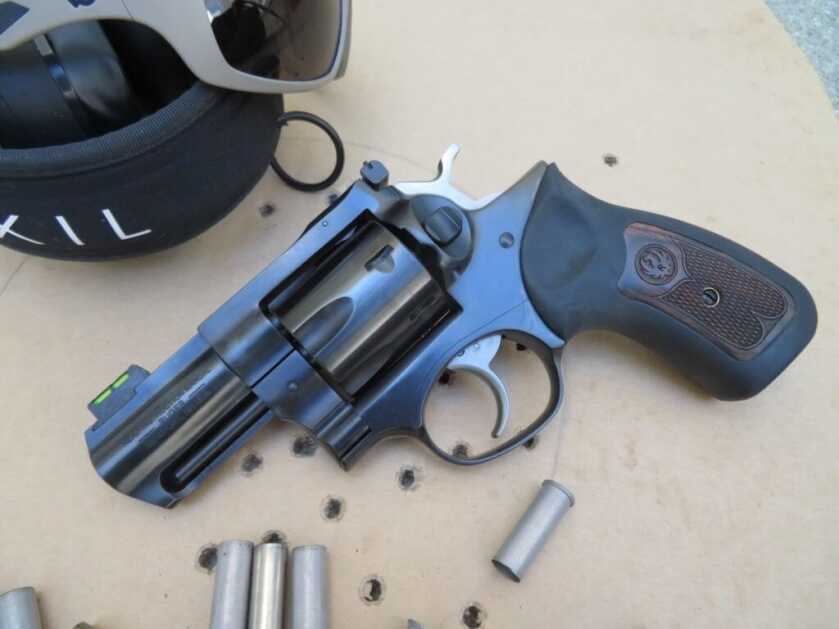
Estimated reading time: 10 minutes
Some may think the revolver days are numbered, but in reality, wheelguns are still an excellent choice for EDC. Snubnose revolvers were after all the original concealed carry gun. Recently Ruger teamed up with Talo Distributors to create an exclusive variant of Ruger GP100 that is a fine example of a modern snubnose.
Table of contents
Talo GP100 – A Modern Snubnose
This Talo GP100 features a 2.5-inch barrel, compact rubber grip, green fiber optic front sight, and adjustable rear sight. It is compact as it is solid. The GP100 is a medium-frame revolver and built like a brick outhouse, meaning it is larger than the typical .357 Magnum snub nose and a bit chunky. By, hey, there’s more to love and hand onto, right?
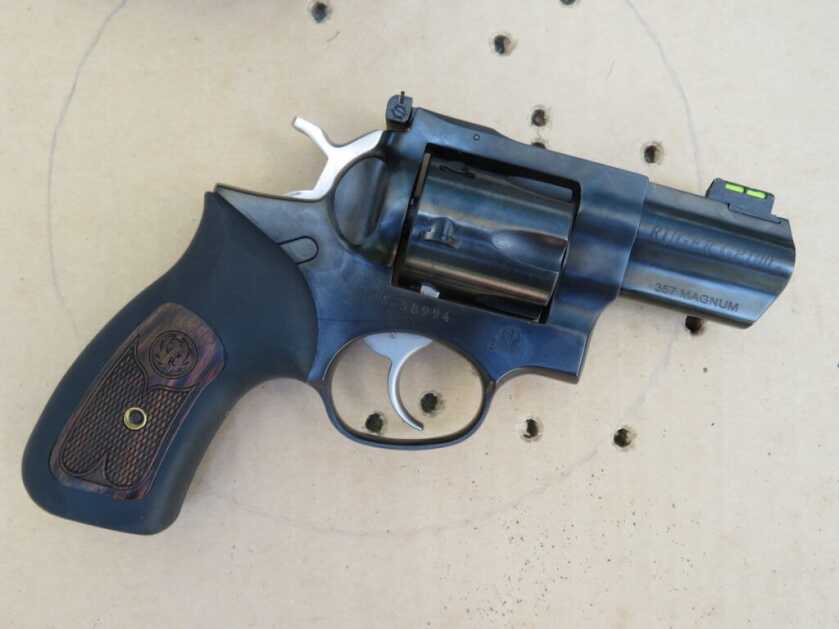
The Ruger GP100 was originally designed to withstand the pounding from full-power .357 Magnum loads; built to last through thousands of rounds of magnum ammo with no cracked forcing cones, stretched frames, or other damage from magnum ammo. The reality is most shooters will run 38 Special ammo in this gun for training and load .357 Magnum cartridges for self-defense. Over-engineering the revolver is smart for longevity, but the end user is left with a bulky revolver. That’s not necessarily a bad thing as I found out.
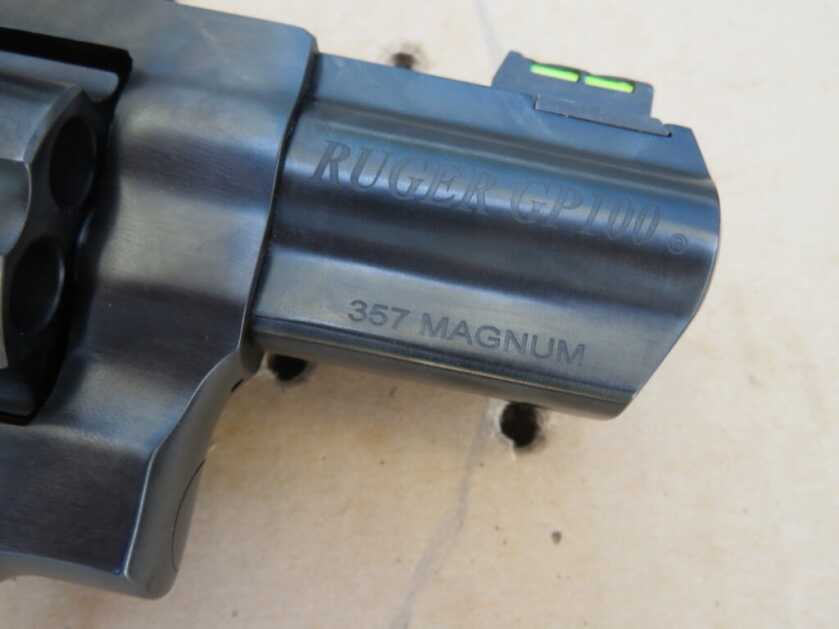
Talo GP100 – A Very Unique Revolver
Like other Ruger DA/SA before it, the GP100 is unique from revolvers from other revolvers because it uses a one-piece frame and can be easily field-striped. The hammer and trigger assembly is designed to be easily taken apart. Revolvers are not typically easy to disassemble, but Ruger made it easy to completely take apart the revolver for a thorough cleaning.
Revolvers from Taurus, Colt, Kimber, and Smith & Wesson all use a two-piece frame with a side plate. Ruger revolver frames are cast, not forged like an S&W, so they are characteristically heavier and thicker. A unique feature of the GP100 when it was introduced in 1985 was the grip frame, a peg designed to accommodate a wide variety of grips. The GP100 also uses a hammer transfer bar to prevent an accidental discharge if the revolver is dropped.
In my opinion, Ruger and Talo did a good job of trying to make a compact revolver out of Ruger’s medium size GP100 revolver. The Ruger looks a bit portly and weighs in at 36 ounces unloaded. As I found out the weight of the revolver was an asset. The Ruger was a comfortable gun to shoot even with hot magnum loads.
Available on GunsAmerica Now
Chubby And Move To Love
Like I said the revolver’s weight is an asset to help reduce felt recoil, but it also takes more effort to tote the revolver. I would have liked to see a few ounces shaved off by rounding the edges of the frame and barrel; maybe some fluting in the frame. I know that I’m being an armchair engineer, but I do think some additional machining could have been done to make the revolver even better and more manageable for conceal-carry.
The 2.5-inch barrel allows for a longer ejector rod, which makes it easier and faster to dump empties from the cylinder. Ruger tapered the under lug for smoother re-holstering. The metal finish is deep blue with a contrasting stainless trigger and hammer. Exactly what I expect from Ruger.

Compact Grip Fills That Gap
The compact rubber grip is user-friendly. It fills your hand and is short; sized right for conceal carry while still providing recoil reduction when pounding away with magnum ammo. The rubber was a bit catchy on thin covering garments. Checkered wood inserts provide texture for your palm and give the revolver a more traditional look. Ruger offers larger grips and there are plenty of aftermarket grips for the GP100 model series if you want to swap them out. For EDC I’d keep the supplied grip. The grip allows for a high hold and fills the gap between the rear of the trigger guard and grip front strap. With magnum revolvers that gap can jam the joint of the middle finger on your firing hand, making it uncomfortable to shoot magnum rounds.

HiViz LiteWave Front Sight
The HiViz LiteWave green fiber optic front sight offers a bright green dot that is easy to see and fast to pick up in recoil. The front sight is dovetailed into the top of the barrel and can be replaced by pushing the front sight plunger in with a small punch and sliding out the sight. This is a nice feature especially if you want a different front sight. You can also get replacement pipes in white or red. The rear sight is adjustable for windage and elevation. The rear notch has a white outline. In use, the fine white outline gets lost when you focus on the green dot. I would prefer the notch in the rear sight to open up a bit so I can see more light on the sides of the front sight, especially for fast shooting. These sights worked well.
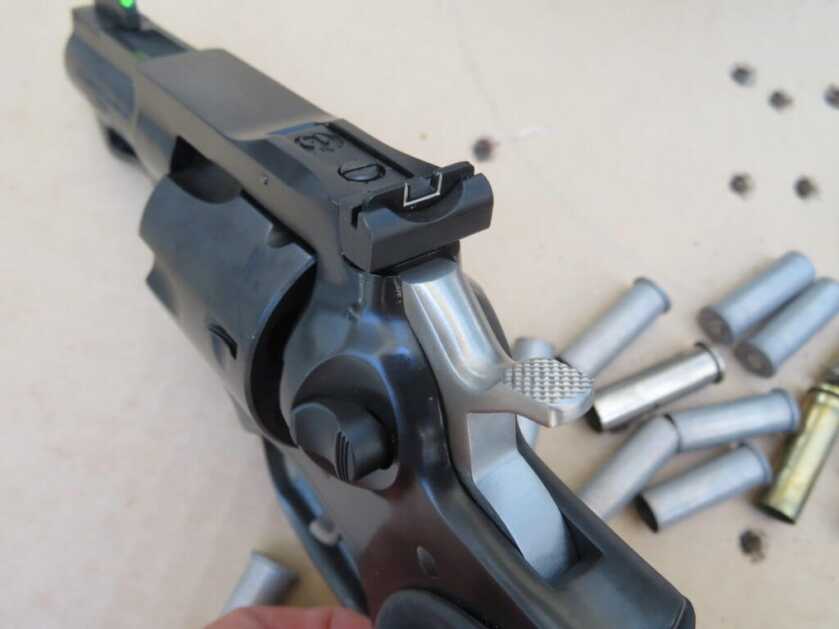
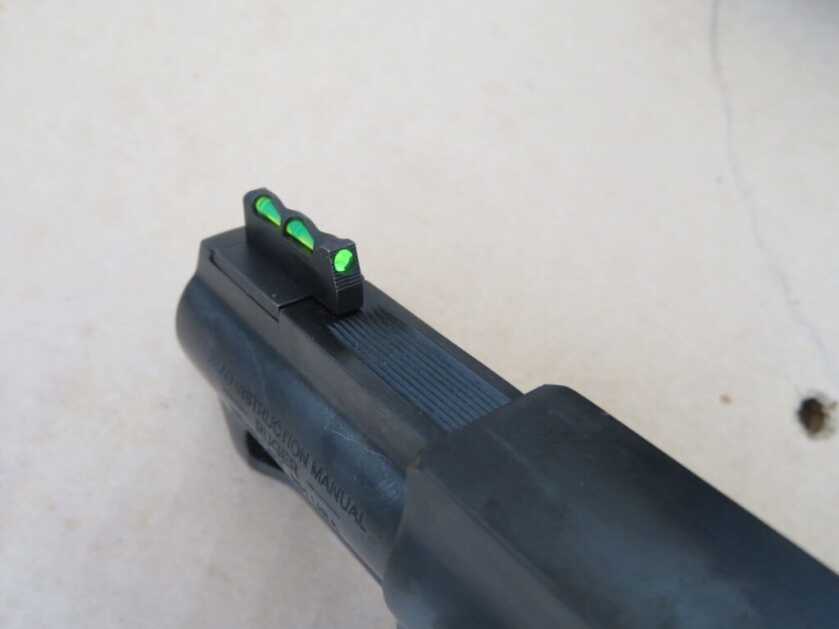
Triple-Locking Cylinder
The cylinder latch on a Ruger is pressed into the recoil shield to open the cylinder. It operated smoothly. There was some very slight cylinder wiggle but nothing out of the ordinary. The GP100 uses what Ruger calls a triple-locking cylinder that is locked into the frame at the front, rear, and bottom. The front is locked to the frame at the crane via a front latch, and the rear via the ejector rod. Ruger says the bolt, what they call the cylinder latch, helps lock the cylinder in place for more positive alignment. From my perspective, it locks up tight as a safe.
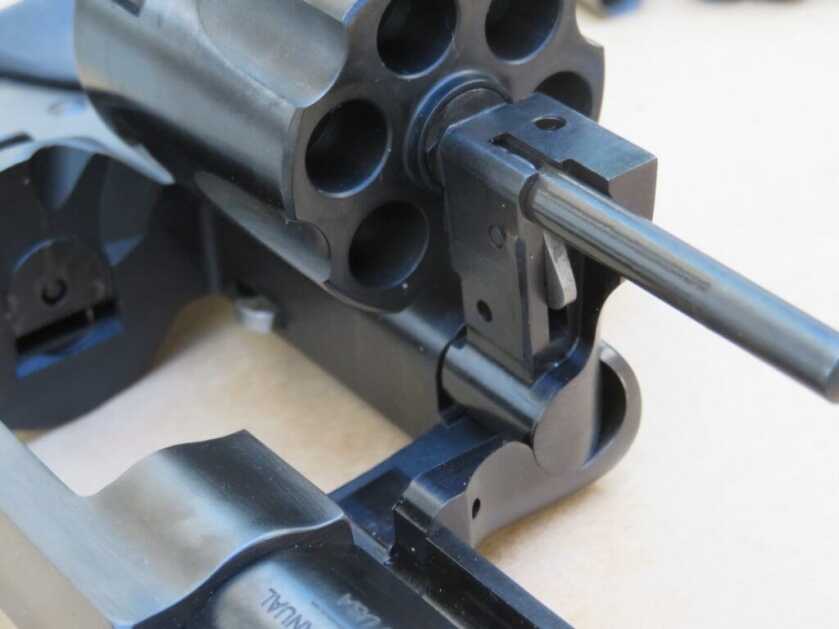
The trigger is wide and smooth, and the hammer spur is wide with toothy checkering for a sure grip when cocking it back. The DA trigger pull was exceptionally smooth and the pull weight measured 12 pounds but it felt lighter. There was little felt stacking. In SA mode the trigger broke at 4.1 pounds, which is good for a defense revolver. Before actual range testing, I dry-fired the Ruger in DA trigger mode to become accustomed to the trigger pull. The Ruger trigger in DA was exceptionally smooth and slick, and I did not have any issues short-stroking the trigger. The firing pin is housed in the frame and the GP100 uses a transfer bar safety system. The trigger needs to be fully to the rear to allow the hammer, transfer bar, and firing pin to fire a round.
Trigger Time With The Talo GP100
A .357 Magnum revolver is as much practical as it is versatile since it is compatible with both .38 Special and .357 Magnum cartridges. Starting at the mild end of the spectrum I ran Speer Gold Dot .38 Special ammo loaded with a 125-grain GDHP bullet. For .38 Special +P ammo, I used Blazer 125-grain HP ammo. And for .357 Magnum ammo, I used Aguila loaded with a 158-grain JSP bullet.
The 158-grain bullet is a sweet spot and the original load for the .357 Magnum. This bullet weight is also very common for .38 Special and .38 Special +P loads. One thing to note is that the .38 Special and +P loads printed higher on the target when using the same aim point as the .357 Mag ammo. This is due to bullet speed and muzzle flip. My best 5-shot group at 15 yards measured 2.29 inches with the Aguila .357 Magnum. Best with the Speer .38 Special ammo was 2.81 inches and the Balzer best measured 2.35 inches.
READ MORE: Ruger: Ranch Rifle in .350 Legend, Competition & Wrangler Revolvers – NRA 2019
The average accuracy was 2.5 to 2.8 inches across all ammo which is fine for self-defense situations. The magnum ammo produced 436 to 475 ft-lbs. of energy and the 38 Special produced 228 ft-lbs. The +P was in between. As a comparison, the muzzle energy from a 3.5-inch barrel 9mm will produce about 230 to 270 ft-lbs. so the 9mm is on par with some .38 Special loads but takes the back seat with .357 Magnum loads.
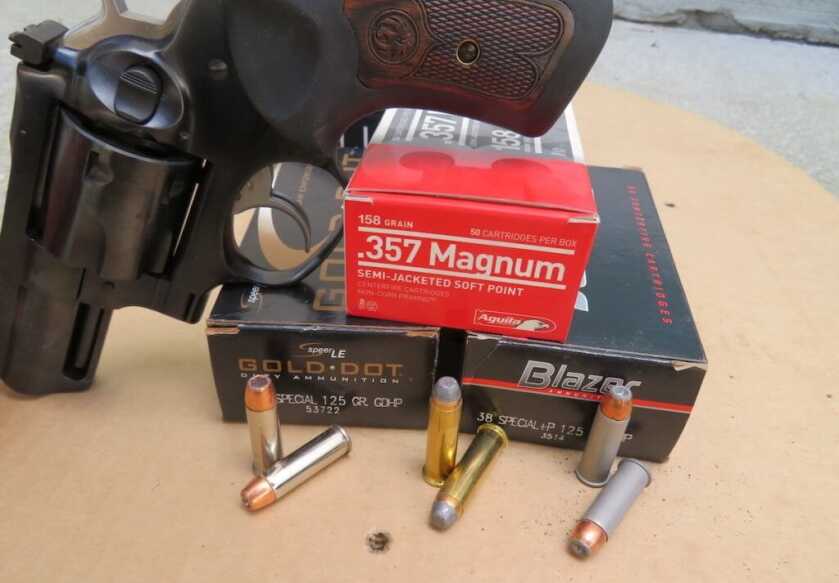
Accuracy Exercise
For speed shooting, I moved to 10 yards and performed Bill Drills by firing at the 8-inch circle on a tombstone in DA mode as fast as I could while still being accurate. This exercise pushes you to that point where too much speed with the trigger can cause a miss on the target. The GP100 is easy to control. I fired additional strings mixing magnum, +P, and standard ammo and thought the felt recoil was very tolerable due to the grip and the weight of the gun. The Ruger is the gun you want to shoot if you are doing high-volume training. Empties were easily ejected with no issues.

Specs For The Talo GP100
- Model 1790
- Caliber: .357 Magnum
- Action Type: DA/SA
- Capacity: 6
- Overall Length: 8.0 in.
- Barrel Length: 2.5 in.
- Maximum Width: 1.5 in.
- Weight Unloaded: 36.0 oz.
- Grip: Rubber w/laser checkered wood inserts
- Front Sight: Post, green fiber optic
- Rear Sight: Adjustable notch
- Trigger Pull Weight (DA): 12 lbs.
- Trigger Pull Weight (SA): 4.1 lbs.
- Safety: Internal transfer bar
- MSRP: $920
The Ruger/Talo GP100 is comfortable to shoot, but less comfortable to carry, making it a bit of a compromise. If you want a good self-defense, combat revolver, this Ruger/Talo GP100 should be on your shortlist.
*** Buy and Sell on GunsAmerica! ***

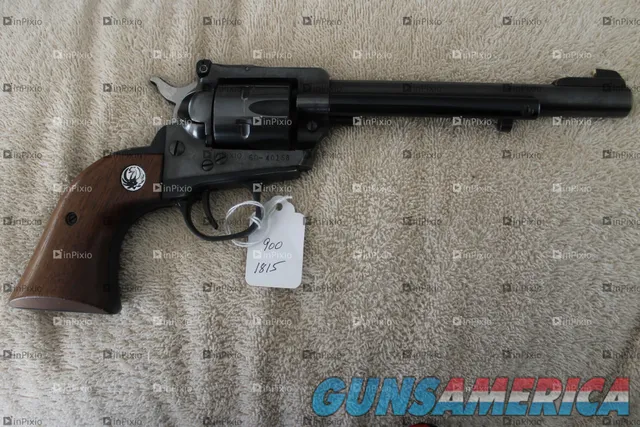
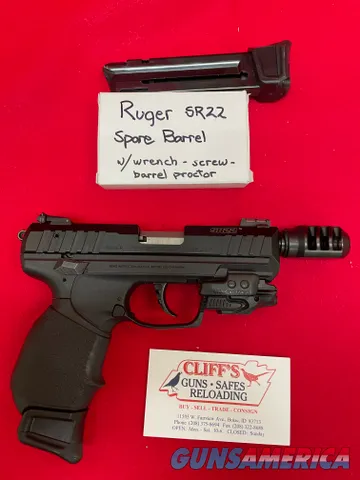

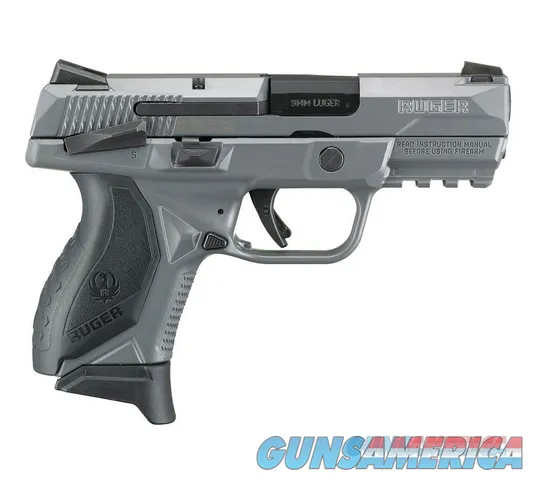
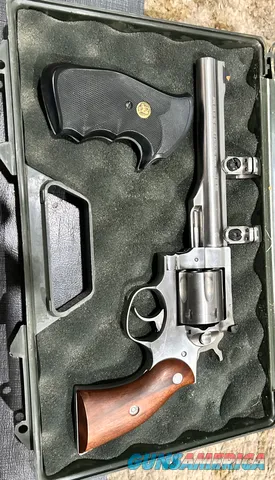
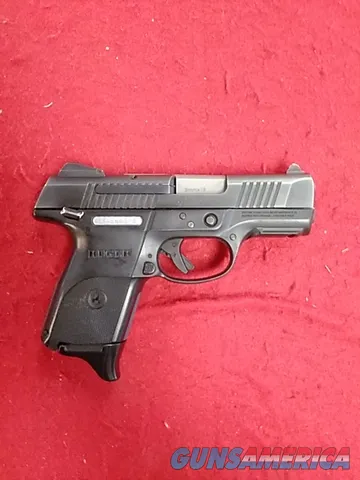
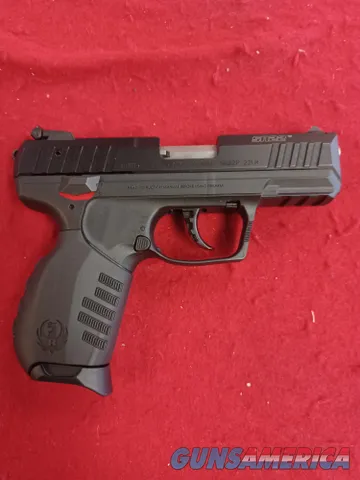
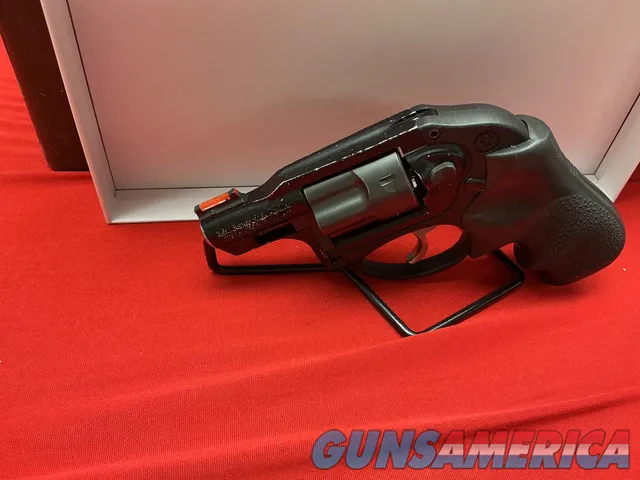
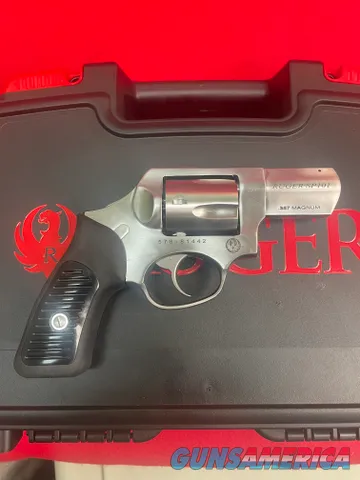
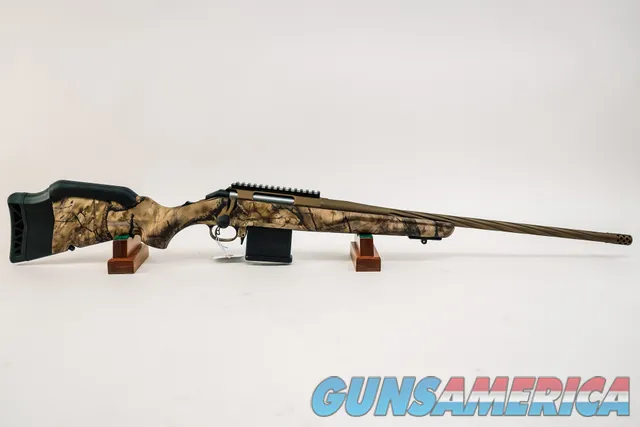

The elephant in the room is: What does a “Talo” model add/change from a regular production line revolver specs? If the gun is touted as a something special, reviewers should write what that is since its driving a higher price tag. Since that info was not provided, I snooped the Ruger site. Appears the adj/high vis sights and 1/2 inch shorter barrel added a couple hundred over Model 1753: the Wiley Clapp Hawkeye.
Talo works with several manufactures to create unique models that fill a mechanical or aesthetic void/niche. So when Talo & Ruger came up with the Model 5152, a stainless Vaquero wilh a barrel length down to 3.75, birds head grip, in .45 ACP (only): it was perfect and didn’t require adding another caliber. A big change from standard Vaquero/calibers.
Talo is a distributer. When Ruger has a “Talo” version it’s simply a variant of the firearm that is exclusively sold through that distributer. Usually it they have a different finish, different sights, different caliber and/or a special barrel length.
I love Ruger and I am drawn to this revolver but have no real application, maybe home and auto. I have lots of CC guns but mostly carry a Ruger LCR without having an auto magazion under constant spring tension. A costly number of nearly 1G for a gun is now common but are you getting a MIM’s ladened product with a barrel liner for that price tag? Are there any bogus “safety” features like some lock device hidden in the handle frame? Still seems way better than the current S&W’s. Yeah sure, I like this gun right now but still some remaining details that might sway me one way or the other
I don’t know why short barreled guns are tested at 10 to 15 yards. Back in the day we shot our back up revolvers at the same distance as our duty revolvers, 50 yards. Most of us also practiced shooting at considerably longer ranges than 50 yards. You never knew if you might encounter someone one with a rifle or have to take a long shot in a building or on the street. People that CCW can run into the exact same situations as a cop. Look at the size of a shopping mall or a Walmart. Everyone needs to be able to shoot their CCW at extended ranges in case they have to stop an active shooter. I practice shooting my 1970’s 2-1/2″ barreled S&W model 19 and a Ruger 2-1/8″ SP 101 out to 100 yds, so I know where it shoots at that range and what hold over I need. I can take body shots at that range on an FBI Q target when I stay on the sights and watch my trigger control. I do qualification out to 50yds and can do the head shots on body armor drills at 50 yds. I consider myself an average shooter. Folks that CCW need to practice at distance and get use to shooting at distance so they are at the very least familiar with it.
Many years ago, maybe around 1991, I bought a Ruger GP100. Other than practice shooting it sits by my bedside as my primary house defense weapon. I did a bit of contest shooting for accuracy just because I was curious. I didn’t win the contests nor did I expect to but I feel I did well enough. It’s a stainless Steel, 4″ barrel completely stock gun and I’m planning to hand it down to one of my sons when I go to meet God.
I might be ridiculed for my choice of carry guns though… LOL Don’t care. I carry a Beretta 3032 Tomcat in 32 ACP. I can put 18 rounds into an 8″ circle at 25 feet, freestyle. Yes I reloaded twice LOL. If I can’t stop the threat with 6 shots then to bad. I started carrying back when the rash of church shootings was taking place. One person enters and starts shooting. That’s the guy I wanted to be able to hit. I don’t care what he’s on if he gets a bullet to the head or throat, he’s not going to be a threat much, if any, longer.
I really don’t understand why people want to carry a weapon with a double stacked magazine of ~17 rounds. If you need that many to stop one or two bad guys you need to practice so you can hit what you’re shooting at instead of missing.
The point of high capacity double stack magazines is that you aren’t guaranteed a single attacker who stands still long enough to allow you to take him/her out with a small number of shots. We no longer live in a world where that scenario is the most likely, now we multiple attackers, sometimes armed with rifles and occasionally wearing body armor so carrying a pistol with a 17 round magazine and one or two magazines is a smart move, not the result of poor marksmanship.
The irony here is that you choose the .32acp, an exceptionally weak cartridge that would almost certainly require a large number of shots on target to stop a threat a as your carry gun while disparaging people who carry a gun that holds 17 rounds.
“LOL Don’t care. I carry a Beretta 3032 Tomcat in 32 ACP. ”
At least you got something especially in Church. So of the standing and kneeling and state laws factor in to some of the choices.
Ruger empty weight 36 oz
Glock 43 empty weight 16.3 oz.; 20.64 loaded
Guess the pocket pistol folks will actually carry. ruger would make a nice bedroom gun. But at msrp of 920.00 I would be into a Smith.
Need two chambered in 10mm
Why two?
Looking at that Ruger, makes me appreciate my S&W 19-3 even more